|
Kriegsmarine Carl Zeiss – eug 10 x 80; 20 degrees
I. Introduction
II. External features of the binocular
III. Internal features of the binocular
IV. Variation between early and later models of 10 x 80 20 degree
V. Accessories and other information
Summarizes
I. Introduction
 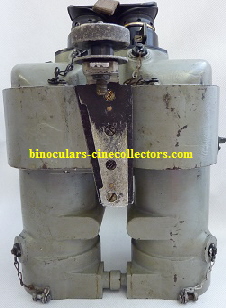
Pict 1&2; the 10x80 20° eug in our collection; ©Anna Vacani
The binoculars presumably were produced from approximately 1939. The serial numbers are Zeiss Astronomy Division numbers.
This model was produced for Kriegsmarine with all the components necessary to use the binoculars on the sea; drying cartridges, air inlet and outlet and the hood with holes for the outflow of the sea water.
During the war the binoculars were used on the German destroyers, escorts, cruisers and battleships.
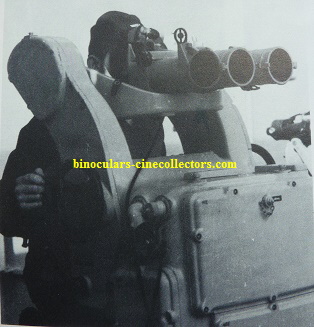 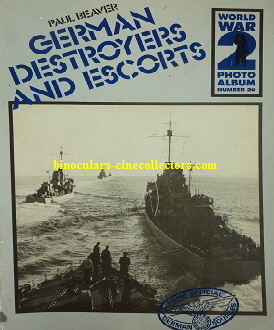
Pict 3; the 10x80 20° photo courtesy of the book by Paul Beaver- visible in the first picture; the book is in our collection.
The binocular was fitted on a top of the special mount, which had an individual adjustment for this model – look at the Pict 2. The binocular was inserted into the guide on the mount.
The binocular was used as land based coastal observation equipment, as well.
Earlier than the war codes were issued (in 1941); the binoculars were marked with logo of Carl Zeiss Jena.
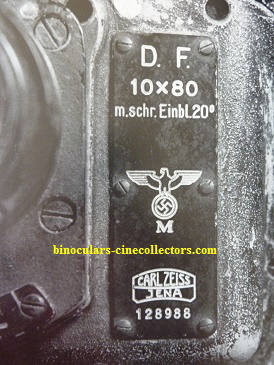
Pict 4; the 10x80 20° photo courtesy of the book by Dr. Stephen Rohan – “Eye of the Wermacht” p.121 ; ©Dr. Stephen Rohan
As we are reading in- Dr Hans T. Seeger –“ Militärische Ferngläser und Fernrohre in Heer, Luftwaffe und Marine; Military Binoculars and Telescope for Land, Air and Sea Service”, the binoculars produced before 1941/ 1942 was not equipped with drying system. We have not seen this version among many of the 10x80 20°.
During the war this model of the binocular was produced by some Companies, in the region of Europe.
1. The Ducati Company made this binocular with marking “mlr” –Ducati, Societa Scientifica Radio Brevetti Ducati, Bologna, and after the war it was marked “Ducati”. You can read the article about Ducati model, on our web site http://www.binoculars-cinecollectors.com/BIMAR-Ducati-Appendix2.pdf.
2. In addition, we have seen this model marked ddx – Voigtländer & Sohn A.-G., Braunschweig.
3. The binoculars were made by Nedinsco Venlo Netherlands as well - marked jux (presumably), and after the war.
4. Additionally, the binoculars 10 x 80 20° were produced, during the war in;
a) Warsaw by – Optische Präzision-Werke G.m.b.H., Warschau, and the binoculars received the war code – eug, the same code as the binocular 10 x 80, 80 degree produced in Warsaw at the same time;
b) and in Jena with war code - blc.
The Carl Zeiss Company’s total production of this model is at least 2750 binoculars, including marked with the war time codes.
We have to point out that all binoculars produced during the war, in other places than Jena, were sent to Jena for testing and to receive Kriegsmarine acceptance and the mark – M IV/1 on the description plate.
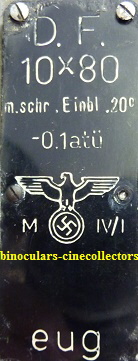 Pict 5; the plate on our 10x80 20° with all markings; ©Anna Vacani Pict 5; the plate on our 10x80 20° with all markings; ©Anna Vacani
The field of view of the binocular at 1000 meters is 122 meters.
We would like to share a history of the one 10x80 20° binocular. We received the book from Guy Hulpiau where he described – in the pictures, a history of one 10x80 20° blc. His best friend –Dr Gorgies Casteur, gave to Guy Hulpiau this model captured from war time ship K4 – Lorelei.
Read the history of the ship from the pictures:
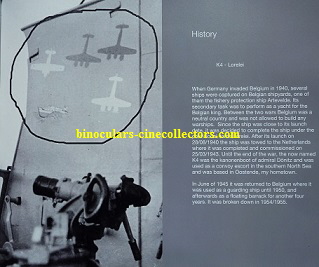 
Pict 6; 10x80 20°; photo courtesy of the book by Guy Hulpiau – “Binoculars Georges 10x80 20°”©G.Hulpiau
The restoration of the binocular to the whole originality took 2 years. The previous state of the binocular is visible in the picture below:

Pict 7; 10x80 20°; before restoration; photo courtesy of the book by Guy Hulpiau – “Binoculars Georges 10x80 20°”©G.Hulpiau
The result of that his hard work can be admired in this picture:
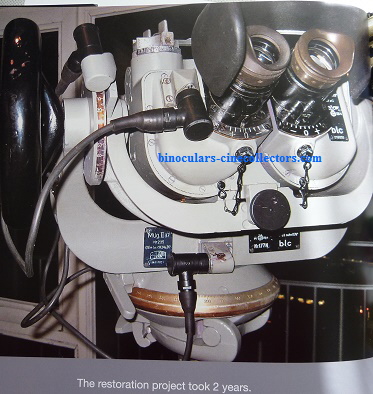
Pict 8; 10x80 20°; after restoration; photo courtesy of the book by Guy Hulpiau – “Binoculars Georges 10x80 20°”©G.Hulpiau
The lamp lightening the reticule – cable with the bulb, was restored as well. The original Carl Zeiss mount was restored likewise.
Every stage and detail of that restoration was observed and consulted in our house.
II. External features of the binocular
The binoculars’ body is built of aluminium alloy. Some parts such as front sighting ring and eye distance regulator knobs are made from brass, but sometime from aluminium. Eye lenses mounts are always made from brass.
We have to underline that the surface of the binocular is painted with a special kind of paint, it is cellulose and finished with light gray.
Our hoods were covered with hammerite paint, by previous owner. To remove the new paint, the hoods must to be knocked to crack the hammerite paint off. The right hood, in the picture, is after all procedure and converted into originality.
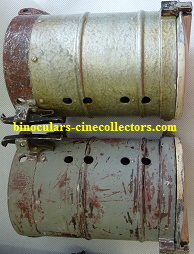
Pict 9; the 10x80 20°; hoods – top hood with hammer enamel and bottom hood with original paint, after removing the new paint; ©Anna Vacani
As the letter “T” indicated all lenses are coated. The blooming on our binocular is in perfect condition.
 
Pict 10; the 10x80 20°; letter T between oculars; ©Anna Vacani
In the above picture are visible the levers attached to the oculars for focusing. The connector for the lamp lighting the reticule is fixed by the left ocular (see Pict 8).
The eye cups are produced from rubber and fitted on a special metal construction. The construction is made from brass. In the rubbers and in the metal construction are made some holes for the comfort of users and for stopping condensation of the eye lenses.
External retaining rings are made from alloy.
Originally the same type of the eye cups were fitted on the 8x60 blc - tall binocular model.
After the war, the West Zeiss Company made a similar eye cups for RWDF 10x 50 periscopes binocular, but slightly bigger and without external retaining rings.
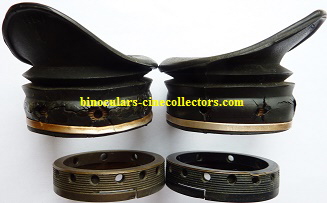 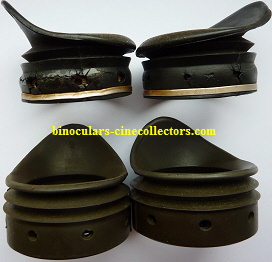
Pict 11; the 10x80 20°; eye cups construction; ©Anna Vacani Pict 12; the 10x80 20° eye cups eug and RWDF 10x50; ©Anna Vacani
The diameter of eye lens is 36 mm and objectives 80 mm.
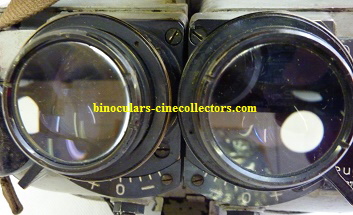 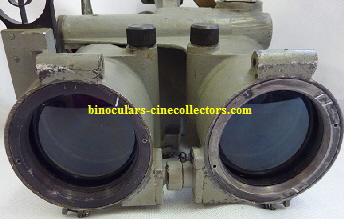 Pict.13; the 10x80 20° eye lenses and objectives; ©Anna Vacani Pict.13; the 10x80 20° eye lenses and objectives; ©Anna Vacani
Beside the right ocular is fixed the plate with description (see Pict 5):
D.F. – Double telescope;
10x80 – power and the objectives diameters
m. Schr. Einbl 20° - with viewing angled at 20°
- 0.1 atü – nitrogen pressurization level /atmospheric pressure/
M/ eagle/IV/I – Kriegsmarine acceptance
eug – producer ‘s war code - Optische Präzision-Werke G.m.b.H., Warschau
On the top of right prism house is fitted rear sight opposite ring sight with a luminous cross.
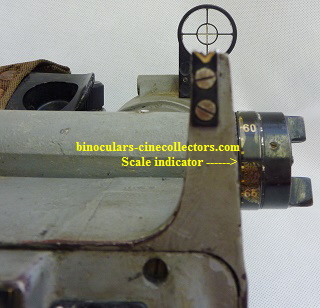 Pict.14; the 10x80 20°; aiming system; ©Anna Vacani Pict.14; the 10x80 20°; aiming system; ©Anna Vacani
Across the body of the binocular is fitted the adjustment apparatus for eye distance. At the end of the adjustment is an eye distance regulator (Augenabstand -eye distance) with a scale indicator (Pict 14).
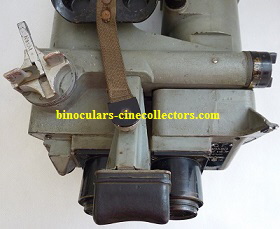 
Pict.15; the 10x80 20°; eye distance tube and filter selector knob; ©Anna Vacani
On the left side is the filter selector knob – marked “Farbglaswechsler” (Pict 10)– Colour glass changer . The lever on the top of the selector may be turn over which selects either day – marked “Tag” or night – marked “Nacht”.
It has to be stated that the night (Nacht) position can be switched only into dark gray filter – protection against blinding from powerful searchlights.
Next features which will be described are waterproofed system, as absorbent cartridges and air inlets and outlets.
The cartridge – marked “Trocken-Patrone” is fitted at the end of the tubes before the objectives – see Pict 1 & 10.
Inside of the cartridges are fitted silica gels which are inserted to absorb the moisture. Some version of this model has a cartridge in each prism box.
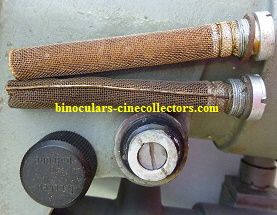
Pict.16; the 10x80 20°; the cartridge with silica gels; ©Anna Vacani
The air inlets and outlets are fitted:
- below the focusing scales, (see Pict 10) marked – “Luft eine” – air in
- and at the bottom of the objectives, marked “Luft aus” – air out, (see Pict 2).
They are attached of small chains to avoid their loss when opened for drying and reduce lens fogging.
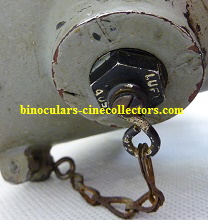 
Pict.17; the 10x80 20°; the drying system; Luft aus ; Luft eine ; ©Anna Vacani
At the objectives are attached hoods. They would be fastened in a very easy way by sliding a metal pin (visible in the picture below). After retaining grub screw is loosen. When the hood is to be opened the metal lever must be pressed underneath the side of the hood.
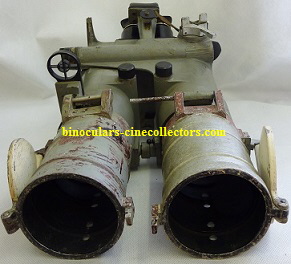
Pict.18; the 10x80 20°; fitting the hoods; ©Anna Vacani
Our binoculars’ weight is 11.6 kg - without double head rest. When other models are found a little lighter than ours, and their weight is – 11.2 kg.
Our model is heavier than blc. Presumably because the prism mount is a different type of construction, and some parts are made from steel. The next point is that our model has a few parts made from brass, which are heavier than those made from aluminium.
III. Internal features of the binocular
The 10x80 20° has Porro II prism optical system. The optics in the binocular are fully coated.
Some of this model has cemented prisms other are not cemented.
Exit pupil of the binocular is 8 mm.
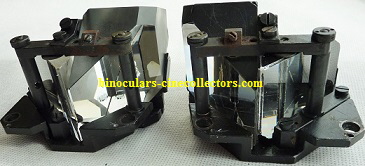 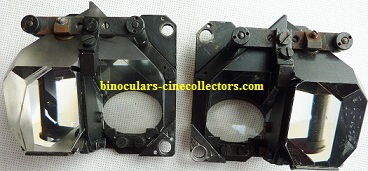
Pict.19; the 10x80 20° prisms –left and right; ©Anna Vacani
The eyepiece contains 6 optical elements in a modified orthoscopic design and one outside cover glass; four are cemented together and the top eye lens is cemented to a flat surface of glass plate.
 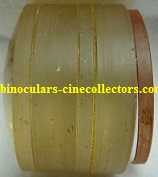 
Pict.20; the 10x80 20° top four eye lenses cemented and flat glass plate; and optic system prisms and oculars; ©Anna Vacani
In some books, you can see schematic diagrams of the ocular lenses without the top glass plate.
Unfortunately, if the top glass will not be cemented to the top eye lens, as it is showed in the schematics, the lens would be moving in the mount.
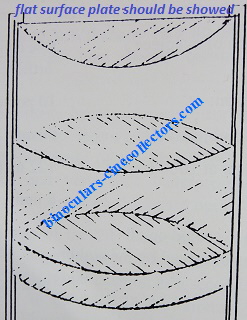
Pict.21; the 10x80 20°; Schematic of the ocular lens, drawing by Kevin Kuhne; without the 6th element; photo courtesy of the book by Dr. Stephen Rohan – “Eye of the Wermacht” p.108; adjusted by Anna Vacani
In the left ocular is fitted an uncomplicated reticule in form of a circle with a small cross in the centre.
 Pict.22; the 10x80 20° reticule; ©Anna Vacani Pict.22; the 10x80 20° reticule; ©Anna Vacani
The filters built in the binocular are in orange and dark gray colour.
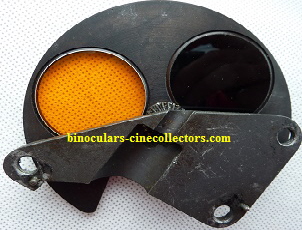 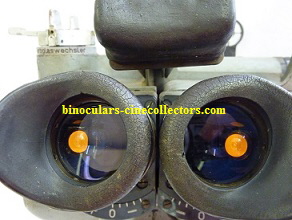 
Pict.23; the 10x80 20°; the filters orange and gray changed in the binocular; ©Anna Vacani
The objectives consists two cemented lenses. The rear element was coated originally.
But this model sometimes has been coated on the front as well, after WWII.
We have seen those binoculars came from Denmark. It is not practical to coat outside surface because on the sea the coating is easy damaged.
IV. Variation between early and later models 10 x 80 20 degree
Since the beginning of the production, this model was made in slightly different versions.
Some models were produced with double headrest.
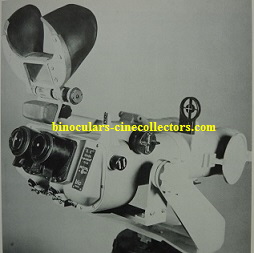
Pict 24; the 10x80 20° blc; photo courtesy of the book by Dr. Stephen Rohan – “Eye of the Wermacht” p.111,113 ; ©Dr. Stephen Rohan
Other version used on the sea, were produced only with the head rest as a fixed part of the body, and with much smaller rectangular pad; see Pict. 10 & Pict. 1.
Some models of Carl Zeiss Jena were produced with red rubber brow pad. Because this kind of rubber, exposed to the light, deteriorates a lot quicker then black or green one, majority of this model was produced with black rubber pads.
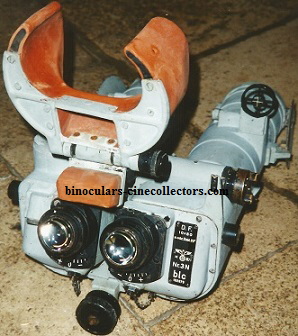
Pict.25; the 10x80 20° with double head rest; ©Jarrolds Marine Archive And Museum
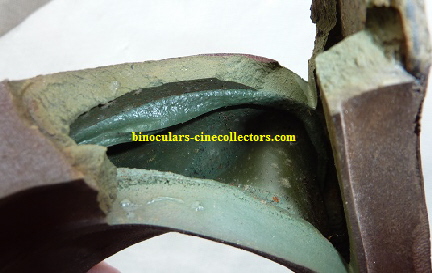
Pict. 26; the rubber pad which was originally green – visible inside, in our collection; ©Anna Vacani
The binocular with the red rubber pads, visible on the pictures, was kept in the original box and was not exposed to the light.
This blc model is slightly different from eug model. The drying system does not have two cartridges – marked “Trocken-Patrone” fitted at the end of the tubes before the objectives. The binocular is equipped into one cartridge, – marked “Trocken-Patrone” as well, and mounted on each side of the prism house;see Pict. 25.
We have seen some pictures of the 10x80 20° without waterproofed elements, as the absorbent cartridges and the air inlets and outlets. The 10x80 20° model produced by factory Nedinsco Venlo Netherlands has a few features different.
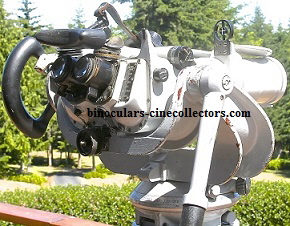
Pict. 27; the 10x80 20° Nedinsco Venlo Netherlands from Dr. Stephen Rohan collection; ©Dr. Stephen Rohan
The top eye lenses on some Nedinsco models are concave surface.
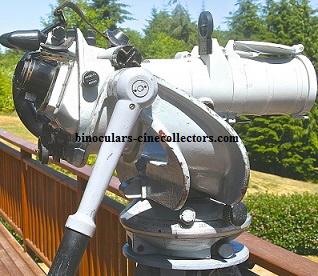
Pict. 28; the 10x80 20° Nedinsco Venlo Netherlands from Dr. Stephen Rohan collection; ©Dr. Stephen Rohan
The hoods are differently constructed. The hood door is clipped back on to the body of the tube on the side, in the eug and blc models – see Pict.24 & 28. In Nedinsco model, it is clipped back on the top of the tube.
V. Accessories and other information
The binocular was transported in a metal case, produced for this model.
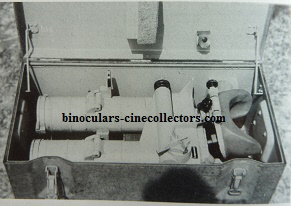
Pict.29; the 10x80 20° blc; photo courtesy of the book by Dr. Hans Seeger ” Militärische Ferngläser und Fernrohre in Heer, Luftwaffe und Marine; Military Binoculars and Telescopes for Land, Air and Sea Service”
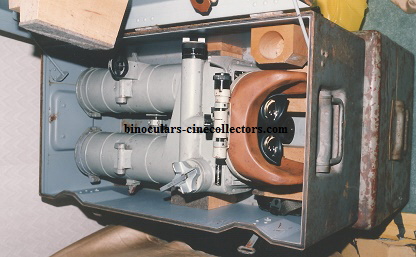
Pict. 30; the 10x80 20° blc in the box; ©Jarrolds Marine Archive And Museum
The binoculars were equipped with the lamp for illumination of the left hand reticule – see Pict 8.
The rain guards are made of Bakelite.
They are fitted to the top of the rubber eyecups (Pict 26). When the binocular is not in use the rain guard strap is locked, as you can see in the picture below.
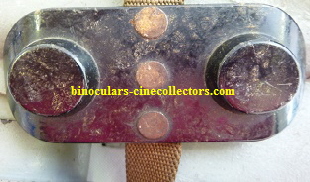 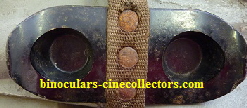 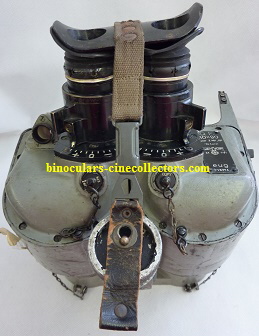
Pict.31; the 10x80 20° rain guard (and Pict.1); ©Anna Vacani
The rain guard is hinged to the top of the objective frame, when the glasses are in use.
Earlier versions did not have the Bakelite rain guard.
The binocular dimensions:
Weight of binocular – 11.6 kg;
Length - without hood with eye rubber – 350 mm; hood – 160 mm;
Width on top - in fully opened eye width position - 250 mm; 230 mm.
Summarizes
The 10x80 20 degree mechanically is stronger made than the 10x80 80 degree model. The eyepieces of the ocular suffer from less light flare then the 80 degree. But the optical performance it is nearly the same. If we have found in perfect examples of both models, the 80 degree would be in some cases have very slightly better optical performance.
The article was based on our knowledge, experiences, literature, old pictures and catalogues in our collection.
Bibliography:
- Dr. Stephen Rohan – Eyes of The Wehrmacht. An illustrated guide to The German World War II; 10 x 80 Binoculars; Volume I. Published by Rohan Optical Press Bradbury, California 1996
- Dr Hans T. Seeger - Militärische Ferngläser und Fernrohre in Heer, Luftwaffe und Marine;
Military Binoculars and Telescope for Land, Air and Sea Service.
Germany, Hamburg 1995; ISBN 3-00-000457-2. The title of the book is in German and English language
- Guy Hulpiau – Binoculars Georges 10x80 20°; Made on a Mac – in our collection
More Kriegsmarine binoculars you can find on page 3 German binoculars.
|